#just the introduction with Campbell's group was so interesting! and that's not even chapter 1!!
Explore tagged Tumblr posts
Text
Just want to share this here because that narrator is fire (and also because my adhd brain could never undertake Worst Journey and maybe I should stop blaming ADHD for the fact that I can't read anymore...)
youtube
Audiobook!
#Polar exploration#Worst Journey in the World#I listen when I can't read anymore and I go back to reading when I feel better so I think that's a good compromise...#Apsley Cherry Garrard#Terra Nova Expedition#That book is amazing... t#just the introduction with Campbell's group was so interesting! and that's not even chapter 1!!
19 notes
·
View notes
Note
Shannon! I have a question for today, it might be a little broad, but how did you come up with Natia’s character? :)
AMY!!! hello! sorry that i have *just* gotten to this as my weeks have increasingly gotten insanely busy between my job starting back up, school, college stuff, and ap exam chaos as well haha! i did this at about 11pm(?) and i'll be queuing it up for the morning for you, but outside of tumblr, i've thought a lot about this question and what i really wanted to include in this question. having almost spent 10 months spent writing and developing natia to who she is today makes a whole lot of stuff move through my brain when i go back to my developing stages for her! thank you for the question (and the broadness, never fear, i absolutely love it!)
Natia's character really came from the idea of just wanting to really push myself out of the box and *out there* to see what I could do. And I will say Landslide is one of my most *out-there* projects in terms of content - I mean we have Death as a personified character, crazy Agent Mortem, all these past connections to Natia? It's chaos haha! But, I had experimented previously with a partly Polish-OC, Hazel Parker of "The Soldier of Stars", and from that, I went, well there's no centrally focused Polish OC yet that I have seen (this was back in like June-July 2020 mind you, so there probably has been Polish OCs created since this time!!) and I had always felt that the Warsaw Uprising was inherently important! I also read up on the Polish Resistance and how they were the most effective resistance group of continental Europe during the war, with ultimately the Warsaw Uprising being their last final push that did sort of end that.
Something I've really enjoyed about creating Natia's character was putting a great focus on her flaws. Now, her strengths are just as important - she is a great soldier in the field, she's highly intelligent and can make quick decisions on the fly, she withholds a lot of strength when it comes to situations where she needs to focus, she's observant, and she keeps herself fairly humble when not bursting at the seems. She doesn't let herself get stepped over very often (unless it's Mortem) and if anything she will insert herself, and show what skills she has, but she won't go overboard. She's also passionate about her country and her people and she always has something to fight for and even when she feels all hope is lost, she withholds a tiny little sliver no matter what, even if she doesn't feel it. But her flaws I feel are a massive part of her character. She's stubborn, she won't let people help her, she has trouble expressing emotion, she numbs herself more often than not to not feel the pain that she is supposed to feel, she blames everything on herself, she gets hot-headed quite easily, and grows to the point of nearly irrational at some moments in time and even will let her emotions get the best of her in times like this. But that makes up who Natia is as a character and who she is as a person in general.
But even with the strengths and flaws of her character, it makes her very much still a human being. And that was one of my main goals when creating Natia - make her human enough to make that angst HURT, but make her human enough that when you see her succeed or even the little wins here and there, you want to cheer. Because those are human moments. And I know this sort of character creation is not for everyone, but for me over the past near-year, this has been one of my favorite things about creating Natia because I've found myself able to relate to her even though I'm so vastly different from her.
I did some research on a British-Polish SOE Agent, Krystyna Skarbek otherwise known as her alias Christine Granville and I took a few liberties from this amazing woman and used it on Natia. But things such as Agent Mortem, Death/War connection and the eventual introduction of another character Solomon Campbell (who will be in Part 3), as well as the Resistance group of Part 1 and her siblings and parents, are all more of my own ideas and connections!
Something I have had a LOT of fun doing is showing that even though on the exterior Natia seems cold-hearted and dark and numb, and whatever other *cold+dark* ideas can be thought up, she is very much underneath -- not that. We can see how much evidently she cares for someone like George Luz; I mean even Joe Liebgott has pointed it out to her. She always is just trying to do her best and do what is best in the situation - no longer it is about what is good or bad anymore to her, it's about doing what's best in the situation for the time being, and I really love that aspect of her character a lot! We can see that when the war ends, she wants to live on the English coast, far away from war all alone with a dog and even a little goat in a seaside cottage. She grew so attached to the word AWOL after Joe Toye came and sat with her that night in Holland and they talked for once about something other than war. She even withheld her name, her nationality and just about everything else to keep the idea of the cold-face agent she thought she was up so the men of Easy Company don't have to know the real her. But -- was it to protect her...or to protect Easy? All these little ideas I threw in there to show that she is actually, very, compassionate in many ways, and caring and attentive and observant of the men and women she works with.
I really try to show that Natia listens when she listens to someone speak and she observes and she pays attention more than anything. And she ends up, holding information like that close to her and finding comfort in it.
My goal with Natia was to show that there can be a balance to "the bad-ass fighter" idea who fights for what she believes, but also remain human as well. We can see how much things affect her, especially the loss of friends. Of course, she doesn't show this to other people, but to use as readers, we see this and we see her occasional breakdown - and in a way, she continues living on their legacies because she listened to what they had to say. For example, Zdzich told her to not let the war overtake her, and throughout the story so far, we've see her sort of repeat this to herself in various ways. Because Zdzich meant that much to her. She's lost so much by this point in war that almost it's so sad to see that she, from what we all know of BoB, still has to go through so much, but at that point, she's fought so much, that all she can do it keep pushing on with it.
I think one of the most interesting moments from writing Natia was when the first few chapters were actually uploaded on platforms and there was someone really coming after Natia for her decisions and for this, that and the other thing (amy if i vaguely remember i think you remember who this person is as well because you clapped back at them once, and man your response was GOLD!!!). One of those things was Natia's approach with food (TW: mentions of struggling to eat with food, references of depression and struggling to eat, mental health issues relating...) and the person who commented would always be saying something about how she needs to eat, and she needs to remain strong and she needs to snap out of it with her depression and all this other stuff and to be honest, I sort of sat there for a moment like??? But there's reasons WHY she's not eating? Why she's holding back? (And of course ones I had mentioned so...) But let's move on.
Mental health was a prevalent thing in World War 2, though it was not looked upon fondly and Natia essentially does have depression as well as a border-line eating disorder. And so when the comment said that she had to snap out of it, I don't know it sort of off-put me because I have family with both those disorders and they've had treatment for it for years and you can't just snap out of it. I really tried to stress that 'the snapping-out-of-it" does not work, and the person kept firing back a bit at it, so I just moved on from it and ignored it. Natia's struggle with eating, as one can see, also comes from the heavy guilt and grief that is slowly uncovered throughout the story of what Natia has done and what has happened throughout the course of the war to her. Natia's number one thing she constantly does and has now become the focus of many character relationships with her (ie Doc Gene Roe) is the clenched fists, that she squeezes until they bleed and eventually need wrapped up by the Doc. Something she also refuses to accept she has a problem with. As we can see, acceptance is a concept she struggles with more than anything and something she will essentially have to learn to simply, accept.
That's just sort of one of the many bits of information about her character that I added, especially in society today as mental health is so important and so I just wanted to share a bit of the backlash I got from someone for it. But I guess that's life, but I'll continue to write Natia Filipska as an OC who does struggle with depression because of her life in war.
Natia's character and her story is probably one of the most complex characters and stories I've written and crafted and created and I'm just extremely happy with how she ended up coming out in the end! I'm about to go and do some writing and editing for her and it's just so exciting writing her because of all these various levels she withholds and she slowly lets uncover as the story unfolds! I just love it! OH - and we can't forget about the infamous mentions of the piano....yep that'll be coming up soon haha!! <3
THANK YOU FOR THE QUESTION AMY!!! IT MEANT SO MUCH!!!! just getting to talk about Natia a little bit and her character and what my mind set was creating her - it means so much. my mindset with her is somehow always changing and shifting as she goes through her character arc throughout the story and how her developmental shifts and it's just something i really love and enjoy more than anything!!! <3 so thank you for letting me just talk about it for a little while as well as my thoughts and opinions, it means a lot :)
#character analysis#natia filipska#agent fidel#landslide#bob fic#band of brothers#band of brothers fic#OC#band of brothers OC#thank you amy!#this was very fun to put together i will say!#tw: mentions of depression/slight eating disorder#ALL QUEUED UP !!!!
19 notes
·
View notes
Photo

For the week of 14 May 2018
Quick Bits:
A Walk Through Hell #1 is largely atmosphere and introduction, as we’re dropped into the lives of a couple of FBI agents, a strange mass shooting at a mall, and the subsequent disappearance of two of their colleagues in a warehouse. Garth Ennis giving us some straight up horror again is very welcome and the tease of what occurs with an entire SWAT unit is enticing for what’s to come. Also, the art from Goran Sudžuka and Ive Svorcina is perfect.
| Published by AfterShock

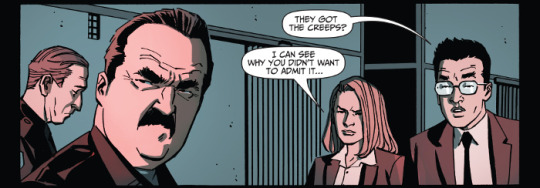

All-New Wolverine #35 brings the series to an end. Over the thirty-five issues, plus an annual and a Generations special, Tom Taylor has delivered one of the most consistently excellent series from Marvel in recent years. The stories have been entertaining, the characters interesting, and contained a nice mix of action, humour, and a real sense of family between Laura, Gabby, and the real wolverine, Jonathan. It’s sad to see it end. But at least it goes out on a high note. This final chapter of “Old Woman Laura”, with wonderful art from Ramon Rosanas and Nolan Woodard, has encapsulated a large part of the fun of this series.
| Published by Marvel



Avengers #2 continues the over the top bombast and destruction of the first issue, actually raising it a bit higher as Ed McGuinness, Mark Morales, Jay Leisten, and David Curiel break out even more action. There is a bit of confusion in regards to Jennifer Walters’ current state, apparently she’s a dumb Hulk again, is built like her angry grey version, but green. It’s like she’s regressed, but there’s no explanation here. Other than that, Jason Aaron progresses the arrival of the Final Host nicely, with an interesting narration from one of the reasons why the Avengers originally came together in the first place.
| Published by Marvel



Avengers: Back to Basics #6 concludes this digital original series. It’s been fun. Peter David’s story has been highly entertaining, with two-issue sub-stories fitting into one over-arcing story involving Ms. Marvel. These past two issues dealing with that mostly head on as Kamala’s dealt with Kang. Also, the art has been great. The first two issues and these last two issues have had the art chores handles by Brian Level and Jordan Boyd, with some very nice page layouts and interesting decisions for panel composition.
| Published by Marvel

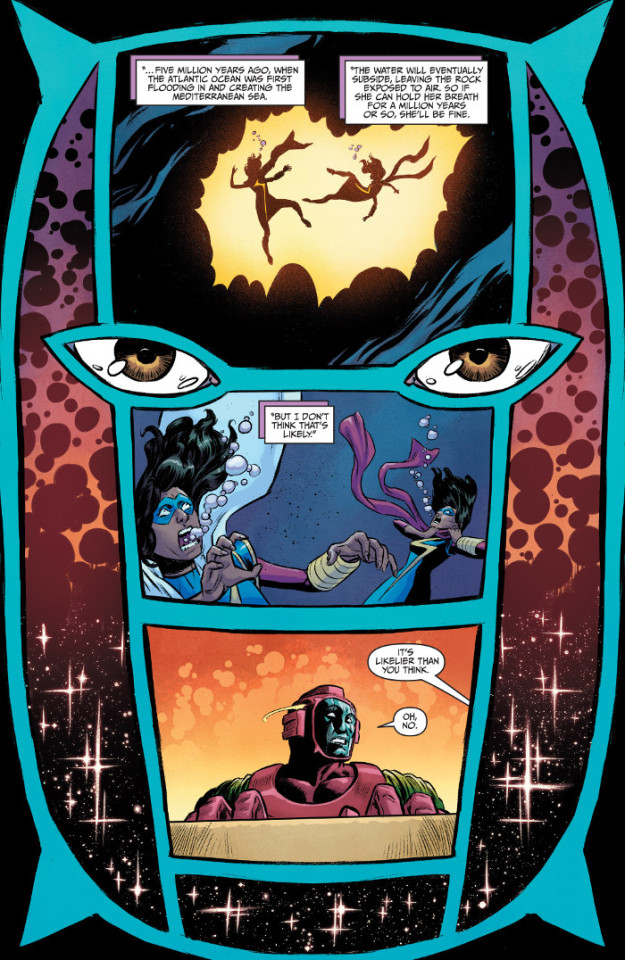

Ben Reilly: The Scarlet Spider #18 has some really nice art from André Lima Araújo. I love his style, basically a mix between someone like Martín Morazzo and Katsuhiro Otomo.
| Published by Marvel



Bloodshot Salvation #9 has Ray Fawkes join in on the writing duties for an excellent standalone story detailing the origin of Bloodhound deep in the trench warfare of World War I. Along with Renato Guedes wonderful art, this is a good story even if you’re not regularly a reader.
| Published by Valiant



Cable #157 continues to play with Cable’s history, past and future, as Nate Grey and a group of alterNates from various timelines are brought together at the end of time to face Metus. It’s interesting how Lonnie Nadler and Zac Thompson are mining Cable’s continuity, while still building new encounters and characters to fill in some of the holes.
| Published by Marvel

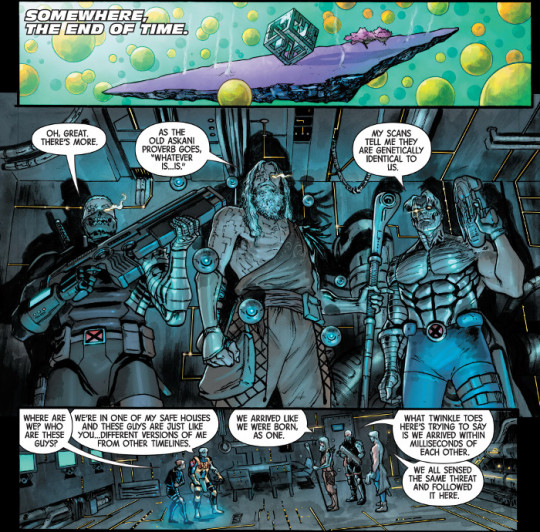

Cold War #4 peels back the curtain just a little bit, to give more hints as to what’s going on truly with the war and its pieces. We get some more insight into LQ, as well as mainly following Sath and Tikk this issue, bringing about some interesting control issues for Vinh. Christopher Sebela and Hayden Sherman have some interesting characters here and the overall future plot just more interesting.
| Published by AfterShock



Crude #1 jumps headfirst into the seedy, unsavoury, and harsh life of working in Blackstone. Interesting to see the rival “gangs” vying for control over the land and the people, as well as giving an insight into what it might have been like for Kiril here before his death. Gerry Brown’s artwork is perfect for this, dark, gritty, and feeling like the characters have walked for ages through mud and worse.
| Published by Image / Skybound



Daredevil #602 gives a good argument for why Mike Henderson is one of the best artists at Marvel right now. He’s great with action and talking pieces, making the various moments of horror, heroism, and humour in Charles Soule’s script shine.
| Published by Marvel



The Dead Hand #2...hoo boy, damn this is a good comic. Kyle Higgins, Stephen Mooney, and Jordie Bellaire are producing a taut thriller and mystery, tapping into Cold War era paranoia and espionage epics and creating something amazing here. The characters are great, fitting perfectly into the spy mould, but the revelations each issue as to what’s going on raise the stakes and storytelling to a higher bar. Also, the art is incredible. This is some great stuff.
| Published by Image



Death of Love #4 gives us a pretty epic confrontation between Philo & Friends and the army of Cupidae. There’s some humour as they work out who the players were in the first issue and set up for the final conclusion next issue. The art from Donal DeLay and Omar Estévez really shines this issue.
| Published by Image

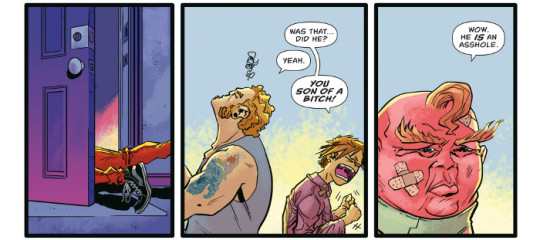

Dry County #3 comes up with some interesting avenues for investigation as Lou continues to try to find out what happened to Janet. Rich Tommaso is mining the trappings of Miami Noir so perfectly, but what I absolutely love is how he’s incorporated even the comic strip into the narrative. It’s not just work, it’s also another tool in Lou’s arsenal as an amateur detective. Brilliant storytelling.
| Published by Image

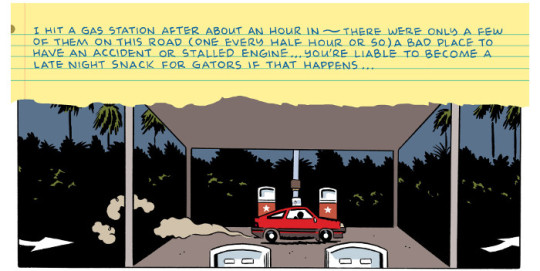

Ether: The Copper Golems #1 is a very welcome return to the world of Ether from Matt Kindt and David Rubín. I’ve said before that Rubín’s art deserves many accolades and the original Ether series was one of the many reasons why, but one of the first in the North American market. It’s just wonderful. A mix of whimsy and detail, with amazing character designs and interesting page layouts, I just love the art. It also helps that Kindt more than pulls his own weight, adding more interesting wrinkles to Boone Dias’ personal life on Earth that makes his departures into the fantasy realm deeper. Also, there’s something sad and somewhat sinister when someone introduces themselves as “Lost”.
| Published by Dark Horse



Flavor #1 is a fascinating creature. It reminds me a bit of the beginning of Joe Keatinge’s other fantasy series, Shutter, somewhat in tone, with beautiful bright art from Wook Jin Clark and Tamra Bonvillain, but also that there seems to be a lot more going on than just what we see at first. That undercurrent has me hooked, but the surface is also rather captivating. Xoo and her dog, Buster, are endearing and the world of fantastical culinary chefs is something different for comics (Moonstruck and Brave Chef Brianna notwithstanding).
| Published by Image

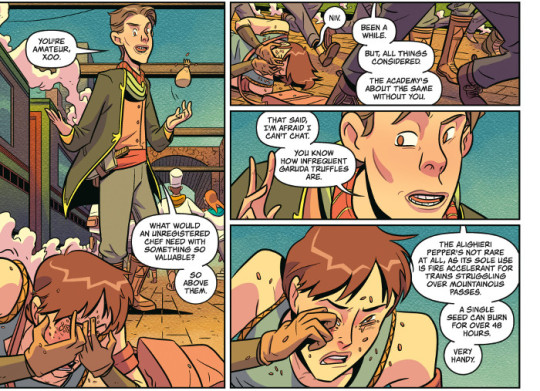

Gideon Falls #3 is another issue full of oblique messages and hints at something insidious as Jeff Lemire, Andrea Sorrentino, and Dave Stewart continue to play the long game when it comes to the horror that’s lurking in Gideon Falls. So far it’s all about atmosphere and building up the characters, with some interesting bits of how Norton’s paranoia and obsessive compulsiveness can bring out some dangerous behaviour, regardless of whether or not he’s actually right.
| Published by Image

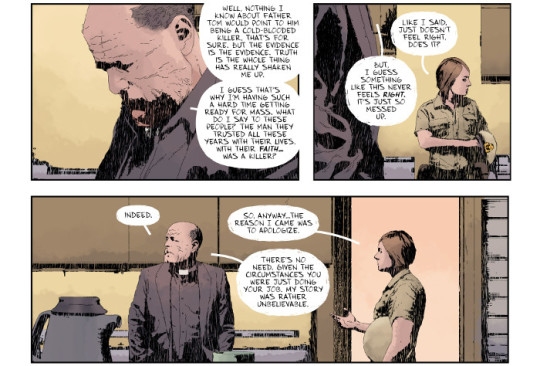

Hunt for Wolverine: The Claws of the Killer #1 is the third limited series, this one following Lady Deathstrike, Sabretooth, and Daken. This one also makes me question some of the status quo of the characters, what with Sabretooth acting more villainous (although there has been a darker turn in Weapon X of late) and Daken’s characterization currently being all over the map between this, Iceman, and X-Men Blue, but taken at face value, this story from Mariko Tamaki is one of the ones that makes the most amount of sense, and looks like it’s going to have an interesting plot on top of just the hunt for Wolverine angle. The art from Butch Guice, Cam Smith, and Dan Brown is really nice. It’s a bit scratchier than I’ve come to expect from Guice, but it suits the darker subject matter.
| Published by Marvel

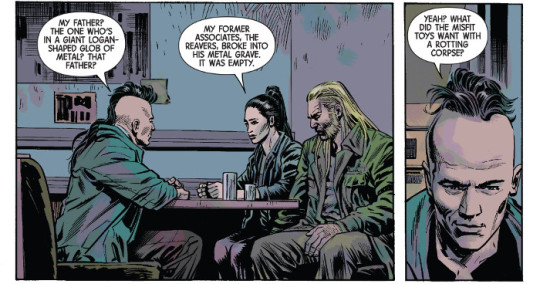

Infidel #3 keeps the hits coming as Leslie’s dead, Kris is hurt but stable, and Aisha is randomly unconscious. Pornsak Pichetshote plays up the racist angle outright here, with Aisha’s friends and neighbours addressing it outright, and it looks like the anger, hate, fear, and division are feeding whatever’s going on. Plus, a notebook full of Goetic sigils and other stuff. Aaron Campbell and José Villarrubia again nail the creepy atmosphere.
| Published by Image



Infinity 8 #3 marks the end of the first part of this series and the first recursion loop. Dominique Bertail’s art is stunning, the designs for the different Kornaliens and all of the dead creatures throughout the necropolis are amazing. It’s also interesting in Lewis Trondheim and Zep’s story how the mystery is going to progress as time resets and the crew tries to learn what’s going on.
| Published by Lion Forge / Magnetic Collection

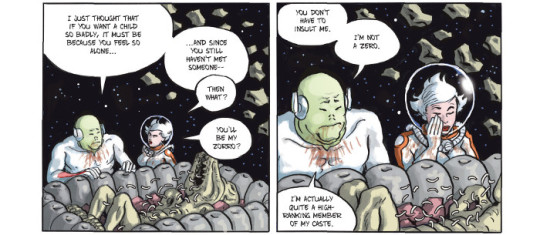

Infinity Countdown: Daredevil #1 is a one-shot detailing how the mind stone came into Turk Barrett’s possession. It’s the kind of fluffy thing that would usually be a couple of panels or a throwaway line in the main series of a crossover, but it’s not bad on its own. I kind of get the impression that all of Infinity Countdown will be better read as a whole, even if the event is just a primer for the forthcoming Infinity Wars. At the moments, it’s just a lot of little disparate pieces. Nice art, though.
| Published by Marvel



James Bond: The Body #5 is another great issue, working as both its own discrete story, with great art from Hayden Sherman and Valentina Pinto, and as part of the broader whole story that Aleš Kot has been serving up in this series. The approach of analyzing Bond from within, piece by piece, has been highly entertaining.
| Published by Dynamite



Kick-Ass #4 is a fairly explosive instalment of the series, with Patience essentially running into a brick wall and finally beginning to assess the ramifications of some of her actions. Still not the moral implications, but certainly the toll that her life of crime would have on her family.
| Published by Image



Lucy Dreaming #3 continues to be a fun read, as we find out a bit more about the world than Lucy dreams herself into and the science project that allows her and her friend Welsey access it. All while delivering a humorous take on the Buffy the Vampire Slayer. Max Bemis and Michael Dialynas are delivering something very imaginative with this series.
| Published by BOOM! Studios



The Mighty Thor: At the Gates of Valhalla #1 is a one shot that acts as a bridge between the latest volume with Jane Foster and the upcoming new series starring the original Thor Odinson. It features two somewhat connected stories by Jason Aaron, the first with art by Jen Bartel spotlighting the Goddesses of Thunder, Thor’s granddaughters from the future who were introduced early on in Aaron’s run, and a second illustrated by Ramón Pérez following Malekith’s plans for the War of the Realms, both nimbly coloured by Matthew Wilson.
| Published by Marvel

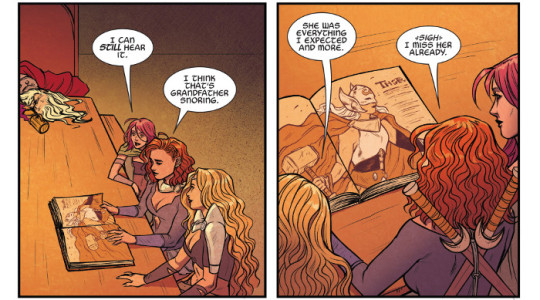

Ninja-K #7 puts together a kind of Unity 2.0 in order to put down the Coalition in Mexico. I love that Christos Gage is playing with the wider Valiant universe for this arc. Often times the stories from Valiant stand on their own save for crossover periods these day, and, while that’s certainly a strength, it’s nice to see that shared universe utilized in entertaining ways. Especially when it means more Doctor Mirage and Punk Mambo. Also the art from Juan José Ryp and Jordie Bellaire is amazing.
| Published by Valiant

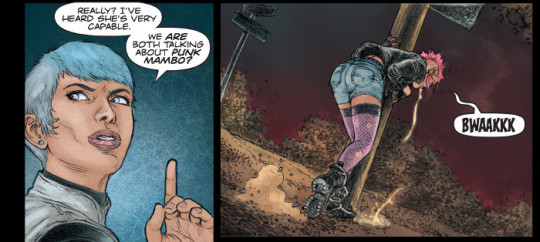

The Punisher #224 brings Frank back stateside for the beginning of one hell of a reckoning in the wake of him donning the War Machine armour and the ramifications from Secret Empire. It does seem a bit hypocritical coming from the hands of Captain Marvel, though. There still really hasn’t been any concrete fallout on her own actions from Civil War II, which is somewhat disappointing. Still, Matthew Rosenberg gives us a good story here as Frank cuts an even more brutal swath through Marvel’s rogues gallery.
| Published by Marvel

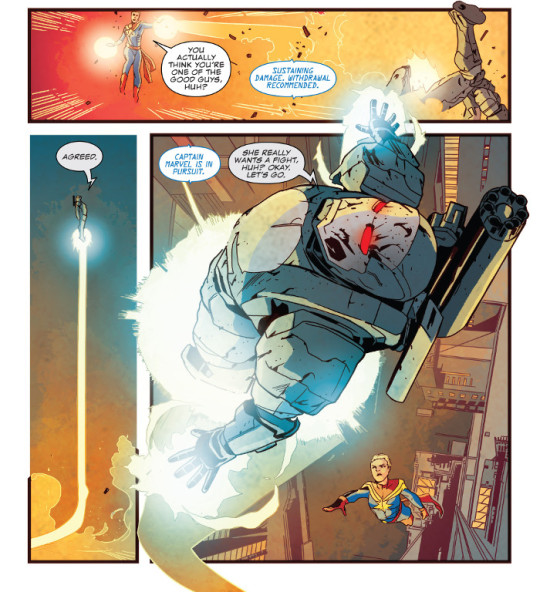

Quicksilver: No Surrender #1 continues on from Quicksilver’s sacrifice run in the Avengers’ “No Surrender” arc with Pietro finding himself unstuck in time. Saladin Ahmed pens an intriguing script, but the real highlight here is Eric Nguyen and Rico Renzi’s art. Particularly Renzi’s colours. The stark contrast between Pietro, the colours of the energy demon thing(s), and the world devoid of colour is an impressive choice. It really makes the story come alive and hammers home the strangeness of the situation.
| Published by Marvel

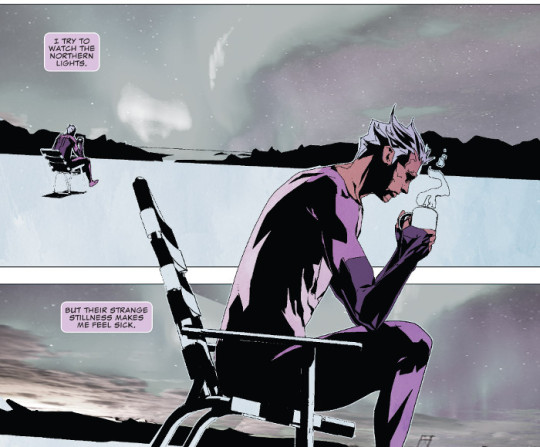

Summit #5 begins the second arc with Federico Dallocchio taking over the art duties, while Amy Chu pens a story that more properly sets up Val’s current status quo and supporting cast at MIT. It’s an interesting approach, an astronaut celebrity professor superhero, and an decent set up.
| Published by Lion Forge / Catalyst Prime



Teenage Mutant Ninja Turtles #82 has more excellent art from Dave Wachter and Ronda Pattison. The story also gets a bit more interesting as the various factions in New York begin to move on plans for something more, even as Baxter Stockman betrays what happened to the Triceratons. Kevin Eastman, Bobby Curnow, and Tom Waltz also expand upon the Rat King, Toad Baron, and their family of immortals in interesting ways.
| Published by IDW

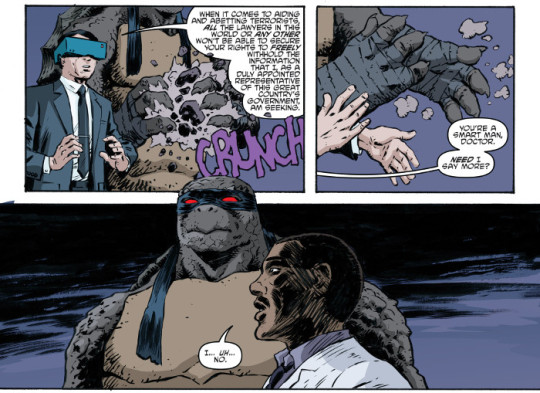

TMNT Universe #22 concludes the two-part story from Paul Allor, Mark Torres, and Ronda Pattison that puts the Utroms and Triceratons on a hard road to peace. It’s a good set-up, despite a foundation on lies, that makes me interested to see what happens next in this tenuous situation. There’s also a nice character piece back-up from Ross May, Chris Johnson, and Mark Englert with Leatherhead and his interpretation of freedom.
| Published by IDW

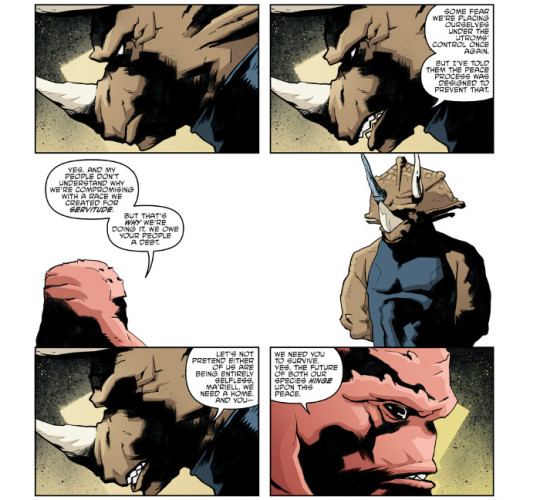

Usagi Yojimbo: The Hidden #3 has Usagi and Inspector Ishida inch closer to the truth as they continue to hunt the murderers of the two unknown ronin.
| Published by Dark Horse



Weapon H #3 is still much, much better than I ever would have expected a book about a Wolverine/Hulk mash-up character would be. Greg Pak, Cory Smith, Morry Hollowell, and Rachelle Rosenberg are doing an impeccable job here, as the over-the-top action continues with Clay facing an squad of Broodlings under the control of Roxxon, while his wife continues to investigate his “death”. There’s a kind of old school sensibility about this series and it’s being utilized to great effect.
| Published by Marvel



X-Men: The Wedding Special #1 gives us a trio of tales in advance of the wedding of Kitty Pryde and Colossus, including a retrospective of Kitty’s history, and one each for the bachelor and bachelorette parties. The retrospective is about what you’d expect from Chris Claremont, wordy and with a penchant to highlight some bits of his time with the character. Honestly, it’s good to see, with some nice art from Todd Nauck and Rachelle Rosenberg.
| Published by Marvel

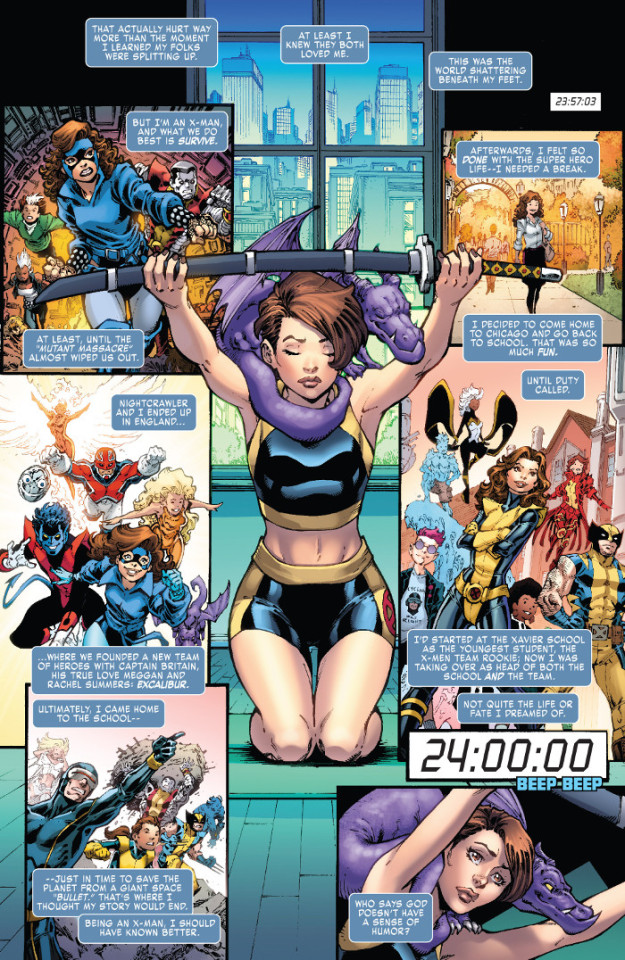

X-Men Red #4 gives us a revelation of part of Cassandra Nova’s plan, weaponizing hate through a new form of nanite sentinel. Mahmud Asrar and Rain Beredo outdo themselves with depicting an impressive confrontation with Storm.
| Published by Marvel

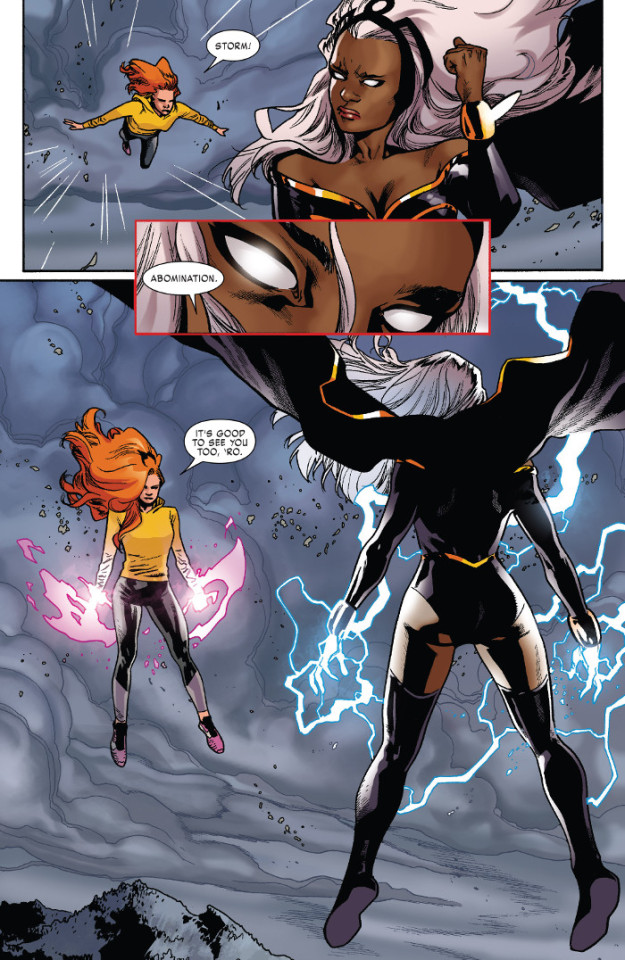

Other Highlights: The Archies #7, Assassinistas #5, The Ballad of Sang #3, Barrier #3, Captain America #702, Cinema Purgatorio #14, Curse Words #14, Encounter #3, Jimmy’s Bastards #8, Mighty Morphin Power Rangers #27, Moonshine #10, The Originals: Essential Edition, Persephone, Riverdale #12, Ruin of Thieves #1, Star Trek: The Next Generation - Through the Mirror #3, Star Wars: Poe Dameron #27, The Wicked + The Divine #36, You Are Deadpool #3
Recommended Collections: The Ballad of Halo Jones - Colour Edition, Black Magick - Volume 2: Awakenings II, Black Science: Premiere Hardcover - Volume 1: Remastered Edition, Evolution - Volume 1, Hulk: Return to Planet Hulk, Infinite Loop - Volume 2, Mage - Volume 4: The Hero Defined - Book 2, Moon Knight - Volume 1: Crazy Runs in the Family, Paradiso - Volume 1: Essential Singularity, Rick & Morty - Volume 7, Star Wars: Poe Dameron - Volume 4: Legend Found, Summit - Volume 1, Turok - Volume 1, The Unsound

d. emerson eddy is not the one you know.
6 notes
·
View notes
Photo

New Post has been published on http://simplemlmsponsoring.com/attraction-marketing-formula/copywriting/buyers-guide-to-the-best-content-marketing-books-of-2018/
Buyer’s Guide to the Best Content Marketing Books of 2018


If you’re looking for a holiday gift book to advance the recipient’s content marketing skills, I have good news. During 2018, authors and publishers created some of the most helpful and sophisticated content marketing books.
I speak from review experience, as I’ve been sharing the plusses and minuses of content marketing books since 2012. Books published in 2018 tended to have better designed covers and short, punchy titles coupled with longer subtitles that described the benefits to readers. In addition, some acclaimed authors returned with new books.
Drivers of content marketing
As in previous years, this year’s roundup focuses on the latest ideas and techniques for increasing conversions. The most effective formula for increasing profits and sales continued to involve increasing the size of your newsletter’s mailing list by offering first-time visitors ethical bribes or content bonuses in exchange for signing up to receive the firm’s .
In 2018, content marketers renewed attention to the why’s and how’s of brand storytelling techniques, almost as if storytelling didn’t exist until January 1, 2018.
As in previous years, many of the best books originated in the growing field of neuroscience – applied brain research. Thanks to authors such as Dan Ariely, we know readers’ brains are highly selective. Messages are filtered for relevance in real time.
In 2019, the most important driver of content marketing will remain neuropsychology, but with an interesting twist – using classic narrative story formats for sharing brand mission and customer.
Bottom line: Whether you’re looking for a book to help you reinvent your content marketing or a gift for someone who realizes they need a fresh approach, the shelves are filled with options. Here are some of the best options published in 2018 (and, in one case, the closing months of 2017).
Make Blue Ocean Shift the first step in reinvention
Blue Ocean Shift: Beyond Competing – Proven Steps to Inspire Confidence and Seize New GrowthW. Chan Kim and Renee Mauborgne
If someone is contemplating a major marketing change, Blue Ocean Shift is an ideal choice. It’s a road map based on the authors’ 30 years of consulting and researching the path to smoother, more successful reinventions.
Thinking about a major #marketing change? The book #BlueOceanShift is a must-read, says @RogerCParker. Click To Tweet
The Blue Ocean Shift helps readers identify and answer the foundational questions before proceeding further. The authors characterize two marketplace types:
Red oceans are traditional, highly competitive markets. They are usually no-growth markets filled with hungry businesses competing primarily on price. Red refers to the color of the waters, reflecting the traditional warfare that has entered a new era of violence.
Blue oceans offer a welcome alternative. They are unexplored and untainted by competition. Blue oceans are vast, deep, and powerful in terms of opportunity and growth. A Blue Ocean Shift emphasizes creating new demand in uncontested market space rather than fighting over a shrinking profit pool.
Just as a map (or GPS system) spells success for a cross-country drive, your team’s answers to the questions posed in Blue Ocean Shift can spell the difference between a successful or unsuccessful reinvention. Blue Ocean Shift details the how’s and the why’s of each step as a reinvention project moves forward. I was particularly impressed by the authors’ description of the steps involved when dealing with members of the various reinvention teams.
The authors emphasize respecting the feelings of everyone involved, while going into great detail for each step. Nothing is left to chance. They even include sample scripts for team leaders to follow during group question-and-answer sessions.
Profit from your most effective and least expensive marketing tool
Talk Triggers: The Complete Guide to Creating Customers with Word of Mouth Jay Baer and Daniel Lemin
The first time I heard about Talk Triggers was an email announcement Jay sent in which he said it was his “best book.”
“Aha,” I said. “We’ll see about that!”
After I read it, I agreed he was right. It is not only an excellent book about an often overlooked aspect of content marketing, but the book itself is a great example to help anyone write an excellent how-to book.
#TalkTriggers is a great example to help anyone writing a how-to book, says @RogerCParker. #contentmarketing Click To Tweet
I was excited to hear that Jay and Daniel wrote a book about word-of-mouth advertising. During the 1990s and early 2000s, working as advertising manager of a fast-growing retail store, I was frustrated by the disconnect between the reality of how we dealt with customers in the store and the owners’ ambivalence about taking the high road and featuring satisfied-customer stories.
My enthusiasm for Talk Triggers is based on three things:
Simple organization. Its structure takes the pain out of reading a complex topic. The authors have spent considerable time organizing the information in a logical format. As a result, chapters are relatively short and appear in a logical order.
Detailed advice. As someone who appreciates the power of word-of-mouth advertising, I was impressed by the depth of information. The authors detail the planning of a strategic “Talk Trigger” campaign and clearly describe how to spread talk triggers throughout the organization. This topic has never been addressed with such detail.
Enthusiasm. The authors describe a strategic campaign, permitting you to learn details that might not be appropriate for broader media, particularly Section Four, Create Talk Triggers in Six Steps, and Chapter 18, Amplify Your Talk Trigger.
Not only does Talk Triggers address a crucially important topic, Jay and Daniel present a model that can teach and inspire the next generation of authors as well. The design and simple graphics are especially appropriate at communicating context without overwhelming adjacent text.
Get your story read and remembered, a step-by-step guide
Storynomics: Story Driven Marketing in the Post-Advertising WorldRobert McKee and Thomas Gerace
“As with the weather, everybody has an opinion, but nobody does anything about it.”
Luckily, however, there’s Robert. He’s a distinguished educator who has devoted his career to sharing the power of story in Hollywood, corporate board rooms, and conferences/workshops. And, luckily, his writing partner Tom is head of one of the most respected and successful content agencies in the world, Skyword. Together, they have written the first practical book about storytelling that offers step-by-step guidance that simplifies a complex process and topic.
#Storynomics offers step-by-step guidance and simplifies the complex process of storytelling. @RogerCParker Click To Tweet
Most books about writing begin with a discussion of Joseph Campbell’s hero journey, a description of the underlying pattern behind most fables, published fiction, and movies. Now, there’s nothing wrong with Campbell’s story and its diagrams of action and reaction except that it often distracts from the current author’s original purpose. I often buy a book titled, A Busy Executive’s Guide to Business Writing (a hypothetical title) and suddenly realize I’m reading a different book, an abstract and theoretical one.
When I found Storynomics’ brief introduction titled The Marketing Crisis, I think, “Good! The authors speak my language.” And I proceeded to read Chapter 1, Advertising: A Story of Addiction. Addiction and advertising fascinate me. They’re more relevant to me than cavemen telling stories around a campfire. Soon, it was daybreak and I was still reading Storynomics.
All first-class books have a step-by-step process, and Storynomics is no exception. It goes through eight stages of storytelling, from the target audience and subject matter, to the inciting incident and objective of desired, followed by the first action, reaction, and the crises choice and closure. The concluding section, Putting Story to Work, contains chapters each addressing a process for each stage.
HANDPICKED RELATED CONTENT: The Content Marketer’s Guide to Story Structure Resurrect the forgotten lessons
Never Lose a Customer Again. Turn Any Sale into Lifelong Loyalty in 100 Days Joey Coleman
The minute I discovered Never Lose a Customer Again, I decided to feature it in the best content marketing books of 2018. It’s not just another customer retention book. It’s a long-needed step-by-step guide or “partner book” that can be paired with implementation books focusing on specific platforms or techniques.
Like Blue Ocean Shift, Never Lose a Customer Again would make a great companion with Jay Baer and Daniel Lemin’s Talk Triggers. It would also make a logical companion to any of the books in the mini review later in this article.
Its provenance is impeccable. Author Joey Coleman has built his international career helping clients reduce customer loss, which undermines most businesses ranging from startups to major brands like Deloitte, Hyatt Hotels, Zappos, and NASA. He helps clients create memorable experiences so emotionally powerful they cause lapsed members to renew their memberships, baseball fans to renew their commitment to a lagging team, and users of personal computers to upgrade their software.
In Never Lose a Customer Again, Joey starts by redefining customer experience and emphasizes how it differs from customer service.
Customer experience & customer service are 2 separate things. @thejoeycoleman #NeverLoseaCustomerAgain Click To Tweet
Customer service refers to, he writes, the “assistance and advice provided by a company to those people who buy or use its products or services.”
Customer experience accounts for emotion. “Customer experience encompasses the emotions a customer feels when they interact with a product or service. When that experience goes beyond what the product or service is supposed to deliver, the customers feel like they have a great experience and become emotionally involved with the brand,” Joey writes.
But, when things go wrong, customer emotion can quickly turn against the business. He continues: “Customer experience, on the other hand, comes on the front end. It anticipates what might go wrong and structures the interactions to avoid this from ever happening. Customer experience is proactive. It’s the environment, the feeling, and the scenario a business creates for the customer to trigger a series of desired emotions.”
The book’s subtitle, Turn Any Sale into Lifelong Loyalty in 100 Days, comes from Joey’s decades of observations working with clients wise enough to look for a structured program to follow the sale. They are wise enough to understand that their company’s future depends on what happens in the first 100 days. As Joey writes, “From the very onset of the relationship, a clock starts ticking and every interaction, touchpoint, exchange, and communication contributes to their overall perception of your company.”
Joey’s 100-day methodology, described in Never Lose a Customer Again, is so powerful that, in most cases, his clients’ competition simply can’t match or outperform it.
Follow your instincts, not best practices
Break The Wheel: Question Best Practices, Hone Your Intuition, and Do Your Best Work Jay Acunzo
Jay is a master rising-star keynote speaker at marketing conferences around the world. But, if you meet him after one of his dynamic presentations, resist the urge to tell him about your Ultimate Underground Guide to Blogging or Your 10 Best Ways to Put SEO in Its Place.
If you’re familiar with Jay’s Unthinkable.fm podcasts or his high-energy keynote presentations at Content Marketing World, you know that Jay doesn’t particularly like formulaic marketing – mindlessly coming up with copy-and-pasted quick solutions like 10 tips, 20 shortcuts, or – in his words– “Oh, well, you get the idea.”
In fact, he has several things to say about supposedly creative people who look for “expert advice” and “proven, step-by-step directions.” Though those ideas worked in the past, they may not work in the future. He fears for the future of a large marketing segment that lacks the “all-in” creative drive of mavericks who trust their intuition.
Of course, as shown by the dismal survey responses that marketers submit each year, management is frequently driven by costs rather than responsive to fresh creative approaches.
For the last four years, on his podcast Jay has been interviewing entrepreneurs who prospered greatly by following their intuition instead of relying on group-think. He shares those stories, like a third-generation headphone manufacturer in Brooklyn, a coffee vendor who used the wrong type of coffee beans, or an encyclopedia editor who dared to introduce humor into serious discussions.
In Break the Wheel, Jay’s first (of many, hopefully) book, he has mined transcripts of his podcast interviews with self-directed individuals (“confident mavericks”) who have found great success and satisfaction defying the..
Read more: contentmarketinginstitute.com
0 notes
Text
Buyer’s Guide to the Best Content Marketing Books of 2018
If you’re looking for a holiday gift book to advance the recipient’s content marketing skills, I have good news. During 2018, authors and publishers created some of the most helpful and sophisticated content marketing books.
I speak from review experience, as I’ve been sharing the plusses and minuses of content marketing books since 2012. Books published in 2018 tended to have better designed covers and short, punchy titles coupled with longer subtitles that described the benefits to readers. In addition, some acclaimed authors returned with new books.
Drivers of content marketing
As in previous years, this year’s roundup focuses on the latest ideas and techniques for increasing conversions. The most effective formula for increasing profits and sales continued to involve increasing the size of your newsletter’s mailing list by offering first-time visitors ethical bribes or content bonuses in exchange for signing up to receive the firm’s email newsletter.
In 2018, content marketers renewed attention to the why’s and how’s of brand storytelling techniques, almost as if storytelling didn’t exist until January 1, 2018.
As in previous years, many of the best books originated in the growing field of neuroscience – applied brain research. Thanks to authors such as Dan Ariely, we know readers’ brains are highly selective. Messages are filtered for relevance in real time.
In 2019, the most important driver of content marketing will remain neuropsychology, but with an interesting twist – using classic narrative story formats for sharing brand mission and customer.
Bottom line: Whether you’re looking for a book to help you reinvent your content marketing or a gift for someone who realizes they need a fresh approach, the shelves are filled with options. Here are some of the best options published in 2018 (and, in one case, the closing months of 2017).
Make Blue Ocean Shift the first step in reinvention
Blue Ocean Shift: Beyond Competing – Proven Steps to Inspire Confidence and Seize New Growth W. Chan Kim and Renee Mauborgne
If someone is contemplating a major marketing change, Blue Ocean Shift is an ideal choice. It’s a road map based on the authors’ 30 years of consulting and researching the path to smoother, more successful reinventions.
Thinking about a major #marketing change? The book #BlueOceanShift is a must-read, says @RogerCParker. Click To Tweet
The Blue Ocean Shift helps readers identify and answer the foundational questions before proceeding further. The authors characterize two marketplace types:
Red oceans are traditional, highly competitive markets. They are usually no-growth markets filled with hungry businesses competing primarily on price. Red refers to the color of the waters, reflecting the traditional warfare that has entered a new era of violence.
Blue oceans offer a welcome alternative. They are unexplored and untainted by competition. Blue oceans are vast, deep, and powerful in terms of opportunity and growth. A Blue Ocean Shift emphasizes creating new demand in uncontested market space rather than fighting over a shrinking profit pool.
Just as a map (or GPS system) spells success for a cross-country drive, your team’s answers to the questions posed in Blue Ocean Shift can spell the difference between a successful or unsuccessful reinvention. Blue Ocean Shift details the how’s and the why’s of each step as a reinvention project moves forward. I was particularly impressed by the authors’ description of the steps involved when dealing with members of the various reinvention teams.
The authors emphasize respecting the feelings of everyone involved, while going into great detail for each step. Nothing is left to chance. They even include sample scripts for team leaders to follow during group question-and-answer sessions.
Profit from your most effective and least expensive marketing tool
Talk Triggers: The Complete Guide to Creating Customers with Word of Mouth Jay Baer and Daniel Lemin
The first time I heard about Talk Triggers was an email announcement Jay sent in which he said it was his “best book.”
“Aha,” I said. “We’ll see about that!”
After I read it, I agreed he was right. It is not only an excellent book about an often overlooked aspect of content marketing, but the book itself is a great example to help anyone write an excellent how-to book.
#TalkTriggers is a great example to help anyone writing a how-to book, says @RogerCParker. #contentmarketing Click To Tweet
I was excited to hear that Jay and Daniel wrote a book about word-of-mouth advertising. During the 1990s and early 2000s, working as advertising manager of a fast-growing retail store, I was frustrated by the disconnect between the reality of how we dealt with customers in the store and the owners’ ambivalence about taking the high road and featuring satisfied-customer stories.
My enthusiasm for Talk Triggers is based on three things:
Simple organization. Its structure takes the pain out of reading a complex topic. The authors have spent considerable time organizing the information in a logical format. As a result, chapters are relatively short and appear in a logical order.
Detailed advice. As someone who appreciates the power of word-of-mouth advertising, I was impressed by the depth of information. The authors detail the planning of a strategic “Talk Trigger” campaign and clearly describe how to spread talk triggers throughout the organization. This topic has never been addressed with such detail.
Enthusiasm. The authors describe a strategic campaign, permitting you to learn details that might not be appropriate for broader media, particularly Section Four, Create Talk Triggers in Six Steps, and Chapter 18, Amplify Your Talk Trigger.
Not only does Talk Triggers address a crucially important topic, Jay and Daniel present a model that can teach and inspire the next generation of authors as well. The design and simple graphics are especially appropriate at communicating context without overwhelming adjacent text.
Get your story read and remembered, a step-by-step guide
Storynomics: Story Driven Marketing in the Post-Advertising World Robert McKee and Thomas Gerace
“As with the weather, everybody has an opinion, but nobody does anything about it.”
Luckily, however, there’s Robert. He’s a distinguished educator who has devoted his career to sharing the power of story in Hollywood, corporate board rooms, and conferences/workshops. And, luckily, his writing partner Tom is head of one of the most respected and successful content agencies in the world, Skyword. Together, they have written the first practical book about storytelling that offers step-by-step guidance that simplifies a complex process and topic.
#Storynomics offers step-by-step guidance and simplifies the complex process of storytelling. @RogerCParker Click To Tweet
Most books about writing begin with a discussion of Joseph Campbell’s hero journey, a description of the underlying pattern behind most fables, published fiction, and movies. Now, there’s nothing wrong with Campbell’s story and its diagrams of action and reaction except that it often distracts from the current author’s original purpose. I often buy a book titled, A Busy Executive’s Guide to Business Writing (a hypothetical title) and suddenly realize I’m reading a different book, an abstract and theoretical one.
When I found Storynomics’ brief introduction titled The Marketing Crisis, I think, “Good! The authors speak my language.” And I proceeded to read Chapter 1, Advertising: A Story of Addiction. Addiction and advertising fascinate me. They’re more relevant to me than cavemen telling stories around a campfire. Soon, it was daybreak and I was still reading Storynomics.
All first-class books have a step-by-step process, and Storynomics is no exception. It goes through eight stages of storytelling, from the target audience and subject matter, to the inciting incident and objective of desired, followed by the first action, reaction, and the crises choice and closure. The concluding section, Putting Story to Work, contains chapters each addressing a process for each stage.
HANDPICKED RELATED CONTENT: The Content Marketer’s Guide to Story Structure
Resurrect the forgotten lessons
Never Lose a Customer Again. Turn Any Sale into Lifelong Loyalty in 100 Days Joey Coleman
The minute I discovered Never Lose a Customer Again, I decided to feature it in the best content marketing books of 2018. It’s not just another customer retention book. It’s a long-needed step-by-step guide or “partner book” that can be paired with implementation books focusing on specific platforms or techniques.
Like Blue Ocean Shift, Never Lose a Customer Again would make a great companion with Jay Baer and Daniel Lemin’s Talk Triggers. It would also make a logical companion to any of the books in the mini review later in this article.
Its provenance is impeccable. Author Joey Coleman has built his international career helping clients reduce customer loss, which undermines most businesses ranging from startups to major brands like Deloitte, Hyatt Hotels, Zappos, and NASA. He helps clients create memorable experiences so emotionally powerful they cause lapsed members to renew their memberships, baseball fans to renew their commitment to a lagging team, and users of personal computers to upgrade their software.
In Never Lose a Customer Again, Joey starts by redefining customer experience and emphasizes how it differs from customer service.
Customer experience & customer service are 2 separate things. @thejoeycoleman #NeverLoseaCustomerAgain Click To Tweet
Customer service refers to, he writes, the “assistance and advice provided by a company to those people who buy or use its products or services.”
Customer experience accounts for emotion. “Customer experience encompasses the emotions a customer feels when they interact with a product or service. When that experience goes beyond what the product or service is supposed to deliver, the customers feel like they have a great experience and become emotionally involved with the brand,” Joey writes.
But, when things go wrong, customer emotion can quickly turn against the business. He continues: “Customer experience, on the other hand, comes on the front end. It anticipates what might go wrong and structures the interactions to avoid this from ever happening. Customer experience is proactive. It’s the environment, the feeling, and the scenario a business creates for the customer to trigger a series of desired emotions.”
The book’s subtitle, Turn Any Sale into Lifelong Loyalty in 100 Days, comes from Joey’s decades of observations working with clients wise enough to look for a structured program to follow the sale. They are wise enough to understand that their company’s future depends on what happens in the first 100 days. As Joey writes, “From the very onset of the relationship, a clock starts ticking and every interaction, touchpoint, exchange, and communication contributes to their overall perception of your company.”
Joey’s 100-day methodology, described in Never Lose a Customer Again, is so powerful that, in most cases, his clients’ competition simply can’t match or outperform it.
Follow your instincts, not best practices
Break The Wheel: Question Best Practices, Hone Your Intuition, and Do Your Best Work Jay Acunzo
Jay is a master rising-star keynote speaker at marketing conferences around the world. But, if you meet him after one of his dynamic presentations, resist the urge to tell him about your Ultimate Underground Guide to Blogging or Your 10 Best Ways to Put SEO in Its Place.
If you’re familiar with Jay’s Unthinkable.fm podcasts or his high-energy keynote presentations at Content Marketing World, you know that Jay doesn’t particularly like formulaic marketing – mindlessly coming up with copy-and-pasted quick solutions like 10 tips, 20 shortcuts, or – in his words– “Oh, well, you get the idea.”
In fact, he has several things to say about supposedly creative people who look for “expert advice” and “proven, step-by-step directions.” Though those ideas worked in the past, they may not work in the future. He fears for the future of a large marketing segment that lacks the “all-in” creative drive of mavericks who trust their intuition.
Of course, as shown by the dismal survey responses that marketers submit each year, management is frequently driven by costs rather than responsive to fresh creative approaches.
For the last four years, on his podcast Jay has been interviewing entrepreneurs who prospered greatly by following their intuition instead of relying on group-think. He shares those stories, like a third-generation headphone manufacturer in Brooklyn, a coffee vendor who used the wrong type of coffee beans, or an encyclopedia editor who dared to introduce humor into serious discussions.
In Break the Wheel, Jay’s first (of many, hopefully) book, he has mined transcripts of his podcast interviews with self-directed individuals (“confident mavericks”) who have found great success and satisfaction defying the experts and their conventional wisdom.
If you listen to Jay’s podcasts, Break the Wheel offers an extra level of understanding. If you’re not a listener, you’re in for treat. You not only have new experts to learn from, but a wealth of valuable ideas.
Podcast takeaways include Jay’s sense of humor. You’ll enjoy Jay’s wordplay. You’ll probably find yourself laughing while listening. (Jay’s sense of humor is, well, eclectic.)
Content marketing should be more challenging and more fun. Content creators should push themselves to higher levels of accomplishment, serving as role models for newcomers. Work environments should become “test centers.” And, as Thomas Edison said, failures should be celebrated as “lessons learned.”
Author your first book
Ideas, Influence, and Income: Write a Book, Build Your Brand, and Lead Your Industry Tanya Hall
The desire to write a book is nearly universal, but until now, there has not been a book to share how to do that in an up-to-date, objective manner with real-world, simplified options.
For decades, Tanya worked with one of the most respected literary agents at a leading agency that has lasting relationships with top non-fiction authors. She’s closely followed the self-publishing trend and currently monitors what she refers to as “hybrid publishing.” She also is an accomplished writer who knows her territory, as well as the strengths and weaknesses of authors.
Ideas, Influence, and Income is ideal for content marketers who have been waiting for a high-level perspective on publishing options and resources. It reads like a conversation with a knowledgeable publishing expert who has prepared for the interview and wants to see new authors treated fairly and with dignity.
The book doesn’t detail unrealistic promises about how quickly readers should expect to finish writing their book or how much money authors can expect to make from sales. It doesn’t offer a “painless, proven formula” for writing a book in a weekend, in three weeks, or 90 days.
It describes why authors should embrace book marketing as enthusiastically as they embrace writing their book. It also respects new authors’ feelings and concerns, such as about not being able to finish their book. It’s a good choice for anybody who has had that notion to write a book.
HANDPICKED RELATED CONTENT: How to Use Your Content Marketing Strategy to Write a Book
More worthy gift books
In contrast to the previously described books that focus on foundations and drivers of content marketing, the following books focus on narrower topics. As such, they make ideal companions for the above books. In many cases, printed copies are available for less than $10.
Aaker on Branding: 20 Principles that Drive Success David Aaker
Although he resides in Australia, David’s books reflect a deep understanding of the challenges facing American marketers. The subtitle of his latest book pays homage to the impatience of American marketers who are not so much looking for “creative” solutions as they are impatiently searching for practical advice they can easily understand and implement.
Beyond Bullet Points: Using PowerPoint to tell a Persuasive Story that Gets Results, Fourth Edition Cliff Atkinson
You might think PowerPoint is past its prime, but you’d be wrong. As Cliff shows, there is a continuing need for compelling SlideShare presentations that can be shared on LinkedIn as well as on your website. Cliff also shows how to use PowerPoint’s Notes feature as a planning tool for video courses.
HANDPICKED RELATED CONTENT: SlideShare Secrets to Stack the Decks in Your Favor
Content Chemistry: The Illustrated Handbook for Content Marketing, Fifth Edition. Andy Crestodina
Each edition is better than the last. Though the information is updated, Andy’s distinctive style remains consistent. The letter-size format and page design set new standards of readability. Andy has a broader perspective than most authors, so he is at home discussing different aspects of web design from multiple perspectives, such as SEO, social media, etc.
Get to Aha! Discover Your Positioning DNA and Dominate Your Competition Andy Cunningham
Written from the perspective of a leading Silicon Valley participant – Andy worked with Apple’s Steve Jobs introducing updated Macintosh computers – Get to Aha! outlines a detailed process for agencies to adopt as they become increasingly committed to content marketing. This is a superb story that marketing teams in large corporations will increasingly appreciate.
The Creative Cure: How to Develop the Right Idea at the Right Time Allen Gannett
This is one of the best creativity books I’ve found. For example, how can two studies of a marketing topic come to totally conflicting conclusions? Allen tells the story of Paul McCartney’s Yesterday, which the former Beatle wrote in a few hours. But it took two years to get the orchestration right. Why? People want new creations, new songs, etc., but they don’t want something totally different. They wanted something new with recognizable carryovers.
HANDPICKED RELATED CONTENT: The Secret to Hitting the Creative Sweet Spot
This Is Marketing: You Can’t be Seen Until You Learn to See Seth Godin
This is Marketing is a compilation of Seth Godin’s latest blog posts on the constantly changing marketing scene. Part inspiration, part advocate, there are probably more useful ideas in This is Marketing than in the curriculum of many a business school. Seth is impatient with overly complex marketing solutions and the slow pace of change. He’s Silicon Valley savvy but wants to see more businesses use proven marketing techniques. Having offline access to his latest thinking is wonderful.
Story Driven: You Don’t Need to Compete When You Know Who You Are Bernadette Jiwa
Throughout the year, Bernadette compiles her recent blog posts into a series of small-format, 5¼- by 8-inch books. Bernadette’s writing is as concise as her mentor Seth Godin’s. Her latest print book, Story Driven, is among her best. It’s beautifully written and designed for easy reading.
Contently Presents The Storytelling Edge: How to Transform Your Business, Stop Screaming Into the Void, and Make People Love You Joe Lazauskas and Shane Snow
Contently is an agency specializing in brand storytelling for content marketing clients. The Storytelling Edge outlines how it has built storytelling into its workflow, and how you can do the same in your firm. It’s a slim hardcover book with lots of stories you can relate to.
Building a Story Brand: Clarify Your Message So Customers Will Listen Donald Miller
This is yet another story of how an agency committed to content marketing, and how it is building close ties with clients committed to a new way of doing things – a content-driven approach. One of the advantages of working with larger clients is a greater likelihood they have internal staff resources to participate in the process, which adds efficiency. One of the best parts of Building a Story Brand is the emphasis on positioning your business as a guide.
Can You Hear Me? How to Connect with People in a Virtual World Nick Morgan
Nick is one of the most respected coaches for A-list keynote speakers. He is a frequent guest commentator on CNN and other channels after presidential debates. His latest book analyzes the pros and cons of virtual meetings and presentations. He is frustrated by the limited bandwidth of most offerings because they filter out many of the vocal cues that permit participants in face-to-face meetings to accurately judge how others are responding to spoken words. He shows how speakers can compensate for the limitations that electronic solutions offer.
When: The Scientific Secrets of Perfect Timing Daniel H. Pink
Dan’s latest book explores the chronobiologic and other research on the interaction between the brain, time, and moods. Telephone calls in the morning, for example, are usually upbeat. But, as the day goes by, calls get shorter and more negative. His research has already resulted in time-oriented books like Chip and Dan Heath’s The Power of Moments, which explains the importance of defining moments in our lives.
Designing Brand Identity: An Essential Guide for the Whole Branding Team Alina Wheeler
Designing Brand Identity is a large, letter-size format compendium of design and copy techniques. Each branding asset is described on a two-page spread. Usually, the resource is defined on the left page with relevant illustrations on the right. The result is a highly visual catalog of branding options.
HANDPICKED RELATED CONTENT: 3 Graphic Design Tips for Non-Designers
Choose the right gift book
When you shop for holiday gift books for content marketers, do your research. Amazon.com permits you to view the table of contents and sample one or more chapters. If the book is available in Kindle format, you can download samples.
You also can print and complete several copies of my Reader Preference Worksheet. Don’t forget to save it so you can use it for gifts for that person later in the year too. (And fill one out for yourself too.)
Now it’s your turn. Have you read any of the books in this guide? What did you think? And what books should be added to the 2018 list? Please share in the comments.
Take your (or your gift recipient’s) content marketing education even further. Enroll in the winter semester of Content Marketing University.
Cover image by Joseph Kalinowski/Content Marketing Institute
The post Buyer’s Guide to the Best Content Marketing Books of 2018 appeared first on Content Marketing Institute.
from https://contentmarketinginstitute.com/2018/12/buyers-guide-books/
0 notes
Link
Hello everyone.Last time on Hawkins Book Club, we learned what synchronicity actually is, time-traveling Neo-Nazis are sticklers for freshly cut grass, there was once a guy who flew around the US in a flying saucer with eight women to look for gold, the KKK uses magick, MK-Ultra actually was connected to Montauk, why the Demogorgon was attracted to Eleven, JFK’s brother liked to trip out on LSD with Nazi rapists, skinheads are actually kind, experienced aura-readers, Mark Hamill is literally the reincarnation of an alien from another universe, the Star Wars films are documentaries, there were Hitler-clones in existence, the Third Reich tried to access the Upside-Down (meaning that we could have had Stranger Things be about the Demogorgon murdering SS Stormtroopers and Hitler clones), Cthulhu and the Elder Gods are real, there could be a whole bunch of UFO-flying Nazis camped out in Antarctica and inside the Earth, George Bush’s dad was insane and there might be a good chance that Brenner is Eleven’s father.First of all, I would like to apologize for not updating this little review column thing last week. There wasn’t an E-book version of this book available, so I had to order a physical copy from a rather… um…. let’s just say “colorful” individual in Wisconsin. To my surprise, when it finally got here I discovered that it was signed by the author himself, so that’s a neat bonus. Speaking of which, the primary author of 1998’s Montauk: The Alien Connection is a new member to the Montauk Party; a guy named Stewart Swerdlow. Without further ado, let’s reconvene the Book Club and jump in.Our old friend Peter Moon writes the Introduction. Here he states that our education system has lied about the nature of space and time.“The biggest secret of time and space that has been unlocked is that these very components of our physicality can be manipulated. This is still a novel idea to conventional scientists, scholars and news media who are manipulated from birth. Manipulation of consciousness comes under the heading of ‘mind control,’ a subject which has never been fully embraced by major media.”Jesus Christ Moon, just let it go. I can’t believe that he’s STILL bitter over being blocked from television. Anyway, he says that mind control is integral to understanding space and time.“The human brain is actually a perfect computer which is fully capable of serving as a tool for cosmic enlightenment to its host. The problem is that this response in mankind has been short-circuited due to any number of various factors. These could include aliens, ancient priesthoods, religious indoctrination, youth groups and the CIA’s documented mind control project known as MK-Ultra. MK-Ultra was a 20th century ‘modernization’ of ancient techniques such as those employed by the ancient Assassins, a Middle Eastern cult during the Middle Ages who programmed subjects to kill through the use of hashish.”I’m starting to think that Ubisoft should be cutting this guy a check too. Anyway, Moon then goes on to claim that not only do truth serum drugs force people to spill their secrets, they also “can be used to tap the collective unconscious”, meaning that someone injected with them would suddenly have omnipotent knowledge about the entire universe… somehow. Moon suggests that we start asking people injected with truth serum about God, evolution “and the very nature of reality” because of this. He also touches on the head of MK-Ultra, Dr. Ewen Cameron and the LSD experiments, interestingly enough. He also states that Preston Nichols now believes that there were “Montauk Girls” in addition to the Boys and that there are literally hundreds of these programmed people all over Long Island. This leads into Moon introducing Stewart Swerdlow, the guy who was given the pseudo name of “Stan Campbell” in Montauk Revisited. You may remember him as the guy who shot Jesus in the face. Regardless, Duncan Cameron helpfully chimes in to say that this guy is an even more powerful psychic than he is. I didn’t know there was a sliding scale of psychic powers, but whatever.Chapter 1 talks about the 1943 Philadelphia Experiment which I’m sure you’re quite familiar with by this point, but it comes with a twist. It focuses on a Nazi named Johannes von Gruber. Why is he there? Well it turns out the Nazis were helping out the Americans with their teleportation.“Such an accomplishment would eliminate war on Earth because whoever controlled this technology would be invincible. The major governments of the world – the United States, Germany, Britain, Russian, and France – would then band together to eliminate the lesser powers and races of the Earth. They planned to beam vast conquering armies anywhere in the universe they desired. The new world government rule the known universe! For this the Reich was willing to unite with the United States. Because of the contacts that the Reich had with a certain group of ‘visitors,’ the United States was also willing to lay aside ideological differences. Each side believed that it would eventually control the entire plan.”………………………………………………………………………………There are so many things wrong with this paragraph alone that it would take an entire post just to point them all out. So I’m going to just move on.Anyway, the experiment actually starts and the shit immediately hits the fan; equipment starts sparking, men start falling overboard, people literally start melting into the floor. So von Gruber decides to jump overboard himself. He woke up at Montauk in 1960 and was immediately accosted by an American military officer and two grey aliens. They strapped him to a chair, gave him a brief update on how that whole “World War II” thing panned out, and another alien came in, tried to comfort him, and then immediately electroshocked him to death. He then rocketed up toward Heaven, complete with angelic guides (because I guess Heaven allows Nazis in now). He then experienced a life review,“Then he was told that he had to complete something on Earth. He was shown a woman in labor in a brand new hospital. The next thing he knew, he was inside a tube of light heading toward her.”Oh God, please tell me this isn’t going where I think its going.But of course, my prayers go unanswered. So cut to a woman named Eleanor giving birth to the author, Stewart Swerdlow. In an interesting synchronicity with Stranger Things, this guy was born on November 5th, 1956.Yes, you read that right, 1956.Somehow, the aliens or angels or whatever sent the Nazi back four years from 1960 to be reborn. No, that doesn’t make any sense, and I’m not going to even try to explain it. So while you’re trying to wrap your head around that, Swerdlow then claims that Yakov Sverdlov was his great-uncle. So how does the first Chairman of the Soviet Union relate to a reincarnated Nazi in the body of an American kid? Well, his grandfather helped form the Communist Party in America and his father worked on military projects in the Southwest. His mother was the daughter of a Gypsy in central Europe who had this experience;“When my grandmother was a little girl in Austria, she was playing outside with two cousins when she glanced up and saw the image of a man who looked exactly like the Jack of Spades in playing cards. Quickly, she told her cousins to look up at it. Immediately, they fell dead to the ground.”Way to go Grandma.“Shortly after that incident, my grandmother was sent to America to live with relatives. Amazingly, nearly a century later, I was involved with a group of government related individuals who were trying to understand the meaning of a message from hyperspace. Beamed from outside the Earth, the message was an image of a being who resembled the Jack of Spades!”Hey aliens, next time can you try making a message that doesn’t kill little girls? And maybe one that actually makes sense? Anyway, the rest of the chapter is just Swerdlow’s turn to recount his shitty childhood, and it’s somehow even worse than that of Nichols and Moon. First off, he said that he saw the spirits of the dead all over the place, there was a constant ringing in his ears, colors “flashed in his eyes” and he had glimpses of the future events that always came to pass. He was constantly frightened and suffering from nightmares. In addition;“Although brilliant in school, I found it slow-paced and boring. Usually I stayed home pretending to be sick, entertaining myself with psychic and mental games. Practically friendless, I found people my own age to be childish and stupid. Instead I preferred the company of the adults, particularly the elderly. For some reason, I enjoyed hearing stories about the old days, especially the 1930’s and 1940’s. I loved watching war movies, but I was ashamed to tell anyone that I always privately cheered for the Germans because my background is Jewish. Interestingly enough, I also cheered for Indians in Western movies.”So I guess this poor boy was still being influenced by his past fanatical beliefs and memories from his time as a loyal officer of the Nazi Party who was also psychic who could see the future, dead people, auras and “mind-patterns”. This seems like something that Stephen King would write, and to be honest I would probably read it. It got even worse for the poor kid as he was constantly being abducted by aliens and exposed to painful experiments by them.Chapter 3 describes one such abduction he experienced when he was six. So the aliens took young Stewart on a quick tour around the world and then brought him to an alien fleet and a council of aliens. Here, a giant butterfly telepathically explains that its species used its DNA to create Earth’s butterflies which are used to “monitor magnetism and know how to adjust it so that it has a beneficial effect on the environment (yes, really). Moths were created as a negative aspect of this by the “dark side.” The butterfly also explains that its species hitchhikes with humanoid aliens in order to populate other worlds and to adopt humanoid “spiritual students”, one of which was Stewart.“Finally, it said that it was time for me to communicate with the other beings, but it wanted me to know that for the rest of my stay on Earth, it would send Monarch butterflies to greet and comfort me. Whenever I saw a white butterfly at an opportune moment, there was a message for me. As the grand butterfly communicated with me, pulsating glows emanated from its beautiful wings.”Next time I see a butterfly, I’m crushing it to fend off these aliens. Stewart is then approached by a big white praying mantis which scares the hell out of him, and a fish person who states that humans had “marine origins”. He then passes out and re awakens in a chair surrounded by more aliens. First a lizard person explains that he is a defector of a massive empire trying to take over the galaxy. He states that thousands of years ago his people came to Earth in a ship that is now the moon. Another ship would come before the end of this century and reawaken the army currently in stasis underground after being defeated by the “Lyraen Empire”. These “reptilians” also maintain bases on Venus and other moons, reproduce mostly by cloning and state that Stewart will eventually convert them to “the Light” because his soul was already an emissary to them long ago. Next up is an alien literally described as looking like the Creature from the Black Lagoon. He claims that his people were the original inhabitants of Earth but were devastated by humans and aliens. However, pockets of them still exist in the deepest parts of the oceans, and they worked as liaisons between the Atlanteans and the whales and dolphins. Apparently these sea mammals are advanced races from another galaxy. I don’t know how advanced they could be if they are so easily hunted down by Japanese whalers, but whatever. Anyway, the Gill-men were transported to Neptune by other aliens.“Continuing, he told me that I have dolphin DNA; therefore, I could learn to communicate with his species in order to help mankind and the dolphin/whale systems.”Oh, so I guess Swerdlow will be the one giving us the heads up when the Vogons get ready to demolish Earth. Next, a Thin Man introduces himself as a representative of “the Federation of Planets”, which is composed of 120 member civilizations, and that they’ll let Earth join if we successfully fend off an invasion by the reptilian empire by ourselves. So I guess their membership requirements are a tad bit more stringent than the UN. He also explains that all of the alien races were speaking to young Stewart because they all contributed DNA to his creation, which his “soul-personality” already agreed to and traveled to other galaxies and alternate universes as training, and that there would be further conditioning in his new life. Seeing as how Stewart is getting all of this dumped on him at the tender age of six, he responds by vomiting all over the alien ambassadors (seriously). This didn’t really seem to faze them as a grey alien then steps over the puddle of vomit to inform the terrified boy that they will be regularly abducting him to check on him, because his body contained chemicals that the greys needed. He also informed Stewart that if his mission fails, then the other alien races would probably fight amongst themselves and bring their war to Earth. Again, Stewart was six when they told him this. At the same age you were worrying about your first day of Kindergarten, this kid was being told that if he screwed up, he would kick off an intergalactic war.So you know, no pressure!So then a Ethereal) identifies himself as a Sirian and tells him that the Sirians created the Egyptian civilization and gave the Torah to the Jewish people. They also created the Crystal Skull, so I guess this means that yes, there actually is a reason for aliens to exist in the Indiana Jones movies. They also possesses the most advanced technology in the universe and intentionally create conflict between the various races to foster evolution. Also, Stewart’s “soul-personality” came from them, so he’s simultaneously both a reincarnated alien and a Nazi. This particular Sirian said that his and the poor boy’s soul-personalities were linked, and he would serve as a guide. As Stewart got older, more memories of his past lives would emerge, and when his “alternate selves come together”, his mission would begin. Stewart was then unceremoniously dumped back in his bed, where he understandably woke up screaming in terror.After this, Stewart would have nightmares about the incident and began developing his psychic abilities. Some strange force compelled him to watch literally everything in the science-fiction genre and read about space travel.“My frustration grew as I realized that there was absolutely no one on the face of the Earth with whom I could converse. Invariably, I wanted to speak about my knowledge of what lay beyond physical reality but was afraid of others’ reactions. In those days (the late 50’s and 60’s), UFOs were still considered to be from the land of the mentally ill.”You know, as opposed to now where they’re accepted as scientific fact. When he got older, he started getting abducted almost every night to be instructed about “physical reality”, time travel and other topics. He woke up extremely exhausted the next morning each time. Because of this, in school he excelled in everything, but was bored and had no patience for other kids and people in general. One day when he was eleven, he was abducted by three greys and taken to a small room with a screen showing a conveyor belt. The aliens telepathically told him to watch pictures appearing on the screen and meat slices corresponding to them and asked to determine if he would eat it or not. This test went on for a bit with all sorts of creatures appearing on screen, and every time he would answer “yes” to something, the taste of it would appear in his mouth. He eventually got incredibly sick because of this and the aliens dumped him back in his bed, pissed because he didn’t finish the test. Stewart was disturbed as he realized that the aliens would have had to kill all of those creatures to get the meat, and one of the pictures was of a man.Chapter 4 talks about his teenage years. His family moved from Brooklyn to Suffolk County Long Island (My home county) and the abductions increased, but in an astral form. He frequently woke up naked in a large room on a bench with a group of other humans and they were educated on their roles as soldiers for the aliens. When Stewart was thirteen, he started “dreaming” about being abducted to a government facility where he was chased by military personnel. When he woke up, he would always see “the face of a blond man surrounded by red light” laughing at him from his bedroom window. He felt like the man was related to him. Also at this point he started undergoing some horrifying examinations by the greys, which are so fucking disgusting that I will not be retyping them here.At this point, he started having a “deep longing for children” and felt that he was a father who missed his kids. This feeling was confirmed when at seventeen he woke up strapped to chair (fully clothed instead of naked for once) and was approached by a grey and a “blond alien”, while two humans in military uniforms watched. He was shown a baby girl that was a hybrid between a human and grey, and was informed that she was his child cobbled together from his genetics. In fact, he fathered multiple children; some of which died and the others were taken to a “safe world”. He was shown this child because the aliens wanted to see if he would form a bond. He did, so the aliens kicked him back to Earth. After this he had the uncontrollable urge to heavily exercise and keep his body in peak condition. The aliens also put in a chip in his eyes that turned them into cameras and gave the aliens some control over where the eyes were directed, which in turned messed with his eyesight. They also started broadcasting his thoughts and past memories onto a screen in order to determine what his future would look like based on his “mind-patterns” during their abductions. The chapter closes out with Swerdlow revealing that the aliens started dumping him in Camp Hero at Montauk.Chapter 5 describes what he did there. It turns out he was dumped there since he was a prepubescent child, during which he was strapped to a table where he was “examined, mentally scanned for my brainwave signature or sexually abused in ways that stored my energetics and magnified them by computer. This went on until puberty.” Seeing as how he only tried to escape once and survived the testing, he was “promoted” by being placed in charge of the younger boys.“The preparation of the children included teaching them to implicitly obey orders, without any questions whatsoever. I taught them how to mentally focus on command so that their bodily energies could be removed by the psychic/mentalist to whom they were assigned. I instructed them on how to know what colors and symbols to mentally use to facilitate any given experiment. They were also taught how to relinquish their bodies and allow themselves to die without the innate defensive reaction of resistance inherent to all living beings.”This is horrifying. He also explains that there’s a difference between psychics and mentalists; the former can only read minds, but the latter can manipulate them. The kids were used to boost the energy of both types of people. The best subjects for this were in the three to twelve age range because their minds were “pure and uncontaminated”. However, their fear led to “scattered and disjointed energy outputs” that were useless to the scientists. And if that wasn’t bad enough, they were sexually abused by various project workers. You’d think the people running this place would prevent the pedos from having access to them because all of this drove many of the kids insane, and so they had to be “terminated”. So instead of giving the kids painless lethal injections, the scientists instead inexplicably shoved them into small chambers were they starved to death, and their bodies were dumped in the ocean. This just seems so unnecessarily evil and inefficient as hell. However, some of the staff would occasionally “adopt” a boy by reprogramming his memories and changing some of his physical features.Some of these boys were the children of politicians or military leaders who were abducted from their beds. They were treated differently from the other kids, and were always returned home, but not before getting implants placed in their eyes and programmed to fulfill unique tasks, which always included “tagging” other boys for use in the Project.The majority of the “expendable common boys” were taken from outside of New York, to alleviate suspicion over the disappearances. They came from all over the country.“Taken from families where they would not be missed as much as others, they were the children of prostitutes, drug addicts, and alcoholics, or they came from poor rural families with many children.”Holy shit, Monty Python was right too!Anyway, if for some strange reason the parents didn’t want to give their son up to bunch of sadistic aliens and Neo-Nazis, then Project people would arrange for an accident, ranging from cars driving into a river to house fires to full on natural disasters to fake the kid’s death. They also grabbed runaways off the street.In addition to the kids, they also grabbed a bunch of homeless people as well to travel through time and space. This tended to be a bit hit-and-miss as many of these people were lost in transit. So if someone did get through, they set up receivers to make transit easier by acquiring “vibrations”. These pathways were opened up by Duncan Cameron, and the Project people literally harnessed the kids’ imagination to boost his powers. When a boy “burned out” from being a living battery, they were exposed to a “fear program” that kicked their adrenaline into overdrive, which got a bit more energy out of them until they either died, went insane, or both. After that, their bodies were handed over to the greys, who proceeded to extract their organs and body fluids into large vats, in which they swam around in like the universe’s most fucked up pool to extract nutrients. Before humans just started handing over kids to them, Swerdlow claims that the aliens created vampires and chupacabras to extract nutrients for them. Occasionally reptilians would show up to watch the mind control experiments. Of course, Swerdlow feels completely awful over his role in all of this and is still plagued by guilt.Chapters 6-8 describe his travels around the Middle East. But first, he described how he hated with a passion, yet studied accounting because he was programmed to do so to help manage the Montauk boys. Also, he nearly died after being injected with sodium pentathol during a wisdom tooth removal. He believes this was because the anesthesia is used in truth serum as well.So he was “compelled” to take an overseas trip “sponsored by a Zionist organization that sought to bring volunteers to Israel and promote colonization of the arid land there.” Essentially, he was going to work on a communist farm called a “kibbutz”. On the way there, he stopped in Italy where the volcano at Pompeii unlocked some his memories of a past life, and a “French woman with Italian citizenship” randomly decided to try and convince him to become a medical doctor and marry her daughter, as one does. When he arrived in Tel Aviv, he was overcome with emotion, but found himself starting at departure board for Teheran, Iran for nearly an hour. He was then compelled to look at departure boards for Addis Ababa, Ethiopia, Nairobi, Kenya and Johannesburg, South Africa until his kind-of-an-asshole program companion got his attention. They waited with three women for a while until a guy came to pick them up. He drove them to Jerusalem where the women were dropped off at a youth hostel and Swerdlow and his companion were dumped at an old, empty British army barracks, where they told to sleep in a cell. When Swerdlow fell asleep, he woke up back at the airport, boarding a plane to Teheran. What follows is a series of flashes in which Swerdlow finds himself in a cave, more naked examinations, a “hyperspace subway system that circled the globe”, a shitty Nairobi bathroom, more examinations and a Sirian who told Swerdlow that he was an ambassador to the Israelis as their ally. Finally, he woke up back in Jerusalem.The next day, a van drove him and his companion to a poor kibbutz called Gvar Am in the Gaza Strip. The trip there was awful, because in Swerdlow’s own words; “Israelis do not drive their cars, they aim them.” He slept in a crappy house and worked in pear groves until the afternoon, “but not before some of the Scottish volunteers became exhausted and passed out from the heat.” He also made a friend with a British guy, whom he later found was an agent for both British and Soviet intelligence. How that’s supposed to work, I have no idea. Regardless, Swerdlow then decides to go meet some relatives in the town of Holon. His bus driver dropped him off, but he had no idea where his relatives actually live, so he wandered around until he literally stumbled into the house of the husband of his grandmother’s cousin.Chapter 8 describes how while wandering the Negev desert, Swerdlow was abducted by the Sirians. They told him that the Hebrews were created by them, and that they were currently trying to “purify” the modern Israelis by altering their mind-patterns. They examined him yet again and showed him his true identity. He was then taken to Mars, where he saw a large group of human men shackled together and digging with shovels. A Rigel alien explained to them that seeing as how they fulfilled their service on Earth and Mars, they would be examined for transportation to Rigel. If they failed the examination, they would be “eliminated.” This whole event was apparently orchestrated just for Swerdlow. He was then taken to the Sirians home world of Khoom, a frozen and snowy world devastated by an ancient war. Here, nine beings called “the Ohalu Council” inform him that he originally sent his soul-personality to Earth and that there were nine other people on Earth like him, each directed by a council member. They remind him of the upcoming war with the reptilian Draco and reveal that just like the CIA in Afghanistan, they also gave weapons to the Draco, who proceeded to use the weapons against them. Swerdlow also discovered that the Ark of the Covenant was actually a communication device between the Sirians and the Hebrews. The Sirians then dumped him back in the desert, three days after he left.“I believe that the Sirians are trying to undermine the plans of all factions involved on Earth; the New World Order, the Draco, the Greys, the Tall Blonds, etc. Their agenda is to bring all events to a climax, then usurp all power, possibly via the Israelis. This is only speculation on my part. Time will tell.”I’m sure it will. Chapter 9 discusses his return to the U.S. Here he reveals that as a young man one of the experiments he was a part of was “The Marriage Project”, which was designed to mate the Montauk boys with specific girls to produce specific children. So the twenty-two year old Swerdlow was matched with a fourteen year old Mia from Massachusetts who “was part of my own frequency”, because their soul-personalities were once one and split off long ago. They then proceeded to have sex while a literal crowd of people watched. Two years later, this happened;“One evening, when Mia was sixteen and I was twenty-four, we were brought together in a clinical environment under the watchful eyes of scientists. Here it was explained that our genetics were perfectly aligned with sequences that were reciprocal to one another. Mia had more Pleiadian genetics; mine were Sirian. This combination would produce a child of unusual abilities. Brought naked into a white room, we made love three times in succession. The entire episode was dreamlike and almost a blur. At the end, I knew inside of myself that Mia was pregnant.”This is so fucked up.So this produced a girl named Jaime, which Swerdlow was prevented from seeing in order to “avoid contamination of her mind-patterns”. She can see the future and “all possible alternate realities”, but at the time of the time of the writing, she was a teenager who didn’t know about her potential. Swerdlow is currently trying to guide her, while she understandably tries to avoid him.Chapter 10 describes how Swerdlow got a job as an internal auditor with a pharmaceutical company. Somewhat hilariously, he actually starts complaining that he has to get up for work in the morning during one of his abductions. During this, his captors tell him that his “marriage” with Mia was over, and that he should go out and live a “conventional life”. So he met with a secretary in the company named Michele, who he detested because she was “nasty and opinionated” with a short temper. However, they were both mind-controlled to marry each other after only a month. They also aborted a child they produced because Michele “did not want to look pregnant when she walked down the aisle.” Swerdlow is sad that he didn’t stop her, and gives the “truth” about abortion;“I now believe that abortion is wrong unless the mother’s life is in danger or the pregnancy is the result of rape. I also understand that the soul-personality does not enter into the body until the first breath, but it is that soul-personality, and no one else, that must decide whether or not to continue the life-stream. People who do not want children should take the proper precautions before the pregnancy, not destroy a possible life-stream after it is created. Although this may sound fundamentalist to some, it is what I know to be the proper way.”Ah, so it shouldn’t being the choice of the mother, the father or the government as to whether a fetus should be aborted, but the choice of the fetus itself, of course!This book.The two had more fights after this and wanted to call off the wedding, but Swerdlow received a telepathic message saying that the marriage would not be permanent, Swerdlow already agreed to it, and “This woman had agreed to be the vessel for the entry of my children into the physical plane.” I have no idea why Michele agreed to marry him, but they did marry and moved to Patchogue, Long Island.Chapter 11 talks about the strange events that occurred at their house. For whatever reason, they usually happened when Swerdlow’s in-laws were staying over. Their house was broken into, but only things that had little value were stolen, they were constantly hearing footsteps in their house, young children tried to break into the house (which he responded to by setting up a six-foot tall fence and alarm system), he saw shadowy figures in the house, the abductions continued and a wire was shoved into his penis, two disembodied robot heads had a conversation over his bed, you know, the usual. He also describes how during one of his abductions a human/grey hybrid young girl was shown to him, and he was told that she was his daughter. His house was also “attacked” several times by black military helicopters that didn’t really do much other than mess with the electronics and radios in the house. His wife was also having dreams of abductions as well, during which she was checked for pregnancy. Every time she had this dream, she became pregnant soon after.This brings us to Chapter 12, which is about Swerdlow’s children, all of whom were delivered via Caesarean-section. The first, Matthew was born in 1983 and was constantly crying, and his parents both had dreams of him being abducted. A couple of months after his birth, Swerdlow was informed during an abduction that his children were “not under my jurisdiction” because they were part of the experiments, and he would have to hand them over. Swerdlow actually grows some balls for once and tells them to fuck off. However, by the time Matthew was seven, he began talking about how a tall, red-eyed man dressed in black came into his room at night and telepathically said that he came from the underground, and that Matthew came from the underground as well, and that his parents were being monitored. Matthew described to his father about how there were cities underground and was able to describe a relay system. He was also abducted by grey aliens, who handed him a space bazooka and told him that he would use it in that upcoming intergalactic war, and that he would get dragged into the same genetic experiments as his dad. Swerdlow also reveals that Matthew was the only kid who inherited his psychic abilities. His second son, Jeremy is probably the most normal person in the entire family, the only strange thing that happened to him was that a grey alien would occasionally come into his room at night and take some of his toys.Next came Daniel. During the pregnancy, the doctor informed his parents that he may be born with Down’s Syndrome. After that, Swerdlow had an abduction during which this happened;“A female grey came into the room holding a small bundle. No one told me that she was female. I simply knew that ‘it’ was a she. As she approached, a male voice said that she wanted to show me something. Slowly unwrapping the top of the blanket, the female revealed an adorable blond-haired baby. The male voice said that it was mine, and asked if I wanted to hold it. Replying that I did, the female started to unwrap the whole baby, revealing an octopus-like torso with legs instead of a human body. Screaming and crying at the same time, I told them to take it away. The same voice said that it was going to an aquatic world and that I would never see it again. Waking up in my bed, I prayed with all my might that Danny would be a normal child. I cannot describe my relief when the doctor called with the positive test results.”So Swerdlow essentially disowned one of his children just because it looked like a complete abomination against God. What a dick.“When Danny started to talk, he told me about a man with a clown face who came into his room at night to take him flying. He said that when the man put a magic wand in the middle of his forehead, they immediately were in a place that had balloon lights of different colors.”So underground inhabitants, aliens, clowns with magical powers, balloons…..…Are the Swerdlow kids getting stalked by Pennywise?)Anyway, the clown took Daniel to see his “baby sister”, who ended up scratching his face with claws. Also, the kid can talk to angels. Not aliens masquerading as angels, but real, honest-to-God angels who tell him the future. This is just casually tossed in on the last paragraph as an afterthought with no elaboration.Chapters 13-14 are about Swerdlow’s CIA application, which was already covered in Montauk Revisited, so I’ll just breeze through it. He simply answered a “Help Wanted” ad in the newspaper, was told that he would be valuable due to his knowledge of ten languages, was asked a barrage of questions during the events described in Montauk Revisited and was declined by the CIA because he was a security risk.Continued in Part 2 via /r/StrangerThings
0 notes